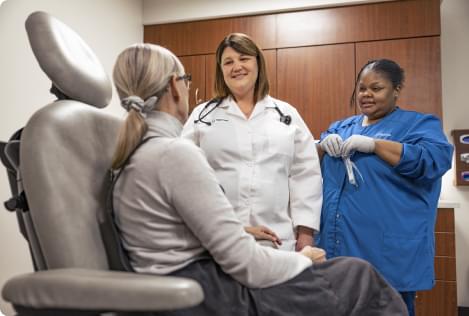Overview
Dry skin makes the skin look and feel rough, itchy, flaky or scaly. The location where these dry patches form vary from person to person. It's a common condition that affects people of all ages.
Dry skin, also known as xerosis or xeroderma, has many causes, including cold or dry weather, sun damage, harsh soaps, and overbathing.
You can do a lot on your own to improve dry skin, including moisturizing and practicing sun protection year-round. Try various products and skin care routines to find an approach that works for you.
Symptoms
Dry skin is often temporary or seasonal — you might get it only in winter, for example — or you might need to treat it long term. Signs and symptoms of dry skin might vary based on your age, health status, skin tone, living environment and sun exposure. They include:
- A feeling of skin tightness
- Skin that feels and looks rough
- Itchiness (pruritus)
- Slight to severe flaking skin, which causes the ashy look that can affect dry brown and black skin
- Slight to severe scaling or peeling
- Cracked "dry riverbed" look to leg
- Fine lines or cracks
- Skin that ranges from reddish on white skin to grayish on brown and black skin
- Deep cracks that may bleed
When to see a doctor
Most cases of dry skin respond well to lifestyle changes and home remedies. You may need help from your primary care doctor or a doctor who specializes in skin conditions (dermatologist) if:
- You've tried self-care steps but your signs and symptoms persist
- Your skin becomes inflamed or painful
- You develop dry, thick skin as a side effect of cancer treatment
- Your condition makes you so uncomfortable that you're losing sleep or are distracted from your daily routines
- You have open sores or infections from scratching
- You have large areas of scaly or peeling skin
Causes
Dry skin is due to water loss from the outer layer of skin. It might be caused by:
- Heat. Central heating, wood-burning stoves, space heaters and fireplaces all reduce humidity.
- Environment. Living in cold, windy conditions or low-humidity climates.
- Too much bathing or scrubbing. Taking long, hot showers or baths or scrubbing your skin too much can dry your skin. Bathing more than once a day can remove the natural oils from your skin too.
- Harsh soaps and detergents. Many popular soaps, detergents and shampoos strip moisture from your skin because they are formulated to remove oil.
- Other skin conditions. People with skin conditions such as atopic dermatitis (eczema) or psoriasis are more likely to have dry skin.
- Medical treatments. Some people develop dry, thick skin after undergoing treatment for cancer, receiving dialysis or taking certain medications.
- Aging. As people age, the skin thins and produces less of the oils needed for the skin to retain water.
Risk factors
Anyone can develop dry skin. But you're more likely to develop the condition if you:
- Are over 40, as the skin's ability to retain moisture diminishes with age
- Live in cold, windy conditions or low-humidity climates
- Have a job that requires you to immerse your hands in water, such as nursing or hairstyling
- Use your hands to work with cement, clay or soil
- Swim frequently in chlorinated pools
- Have certain diseases or conditions, such as hypothyroidism, diabetes or malnutrition
Complications
Dry skin is usually harmless. But when it's not cared for, dry skin may lead to:
- Atopic dermatitis (eczema). If you're prone to develop this condition, excessive dryness can lead to activation of the disease, causing a rash and cracking skin.
- Infections. Dry skin may crack, allowing bacteria to enter, causing infections.
These complications are most likely to occur when your skin's protective mechanisms are severely compromised. For example, severely dry skin can cause deep cracks or fissures, which can open and bleed, providing an avenue for invading bacteria.
Prevention
Try these tips to help your skin retain moisture:
- Moisturize. Moisturizer seals in water to help keep your skin's protective barrier healthy. Use moisturizer throughout the day, especially on the hands. And before going outdoors, use a moisturizer that contains sunblock or a broad-spectrum sunscreen with an SPF of at least 30, even on cloudy days. Apply sunscreen generously and reapply every two hours — or more often if you're swimming or sweating.
- Limit water exposure. Keep bath and shower time to 10 minutes or less. Use warm, not hot, water. Rinse and pat dry. Try to bathe no more than once a day.
- Use a gentle cleanser or allergen-free soap. Try a nonsoap cleansing cream or shower gel. Or use fragrance-free moisturizing soap with no alcohol or allergy-causing substances (hypoallergenic soap), especially if you handwash often. Rinse thoroughly and pat dry. Apply a moisturizing cream while your skin is still damp.
- Shave with care. Shaving can be drying. If you shave, use a lubricating agent before you start. Shave in the direction of hair growth, unless that irritates your skin. Use a sharp blade and rinse it with warm water after each stroke. When done, apply moisturizer.
- Cover as much skin as possible in cold or windy weather. Harsh weather can be especially drying to skin. Scarves, hats, and gloves or mittens help protect your skin when you're outdoors.
- Wear gloves. Protect your hands with suitable gloves when gardening, using harsh cleansers and doing other skin-drying activities.
- Rinse and moisturize after swimming. This is especially important if you've been swimming in a heavily chlorinated pool.
- Drink when you're thirsty. Drink noncaffeinated beverages each day to help keep all your body's tissues, including your skin, well hydrated.
- Bathe babies with care. For babies, using a cleanser every 1-2 weeks for bathing usually is enough. Otherwise, bathe them in just water. However, clean their diaper area with each diaper change. Apply a thin layer of petroleum jelly (Vaseline, Aquaphor, others) while the skin is still damp.
Diagnosis
To diagnose dry skin, your doctor is likely to examine you and ask about your medical history. You might discuss when your dry skin started, what factors make it better or worse, what your bathing habits are, and how you care for your skin.
Your doctor may suggest that you have some tests to see if your dry skin is being caused by a medical condition, such as an underactive thyroid (hypothyroidism). Often, dry skin is a symptom of another skin condition, such as dermatitis or psoriasis.
Treatment
Dry skin often responds well to lifestyle measures, such as using moisturizers and avoiding long, hot showers and baths. If you have very dry skin, your doctor may recommend a moisturizing product formulated for your needs.
If you have a serious skin disease, a doctor may want to treat it with a prescription cream or ointment. If your dry skin becomes itchy, you may use a lotion with hydrocortisone in it. If your skin cracks open, your doctor may prescribe wet dressings to help prevent infection.
Lifestyle and home remedies
The following measures can help keep your skin moist and healthy:
-
Gently wash your face at least twice a day. Use a gentle, alcohol-free, nonfoaming cleanser on your face twice a day and after sweating. Products with stearic acid (found in shea butter) or linoleic acid (found in argan oil and others) can help repair your skin. If you have sensitive skin, wash with a cleanser in the evening and just rinse with water other times.
While your skin is still damp, apply any topical medication you're using, wait a few minutes (see medication packaging for specifics), then apply your moisturizer. If you use cosmetics, consider selecting products with a cream or oil base. Use a moisturizer that contains sunblock or a broad-spectrum sunscreen with an SPF of at least 30, even on cloudy days. Apply sunscreen generously and reapply every two hours — or more often if you're swimming or sweating.
-
Moisturize. Apply moisturizer several times a day, especially when your skin feels dry and after handwashing or bathing, while your skin is still moist. Ask your doctor about the pros and cons of various products for your skin and condition. You may need to try several products before you find those you like, that help you and that you'll use regularly.
Look for healing ingredients such as urea, ceramides, fatty acids and glycerol (also known as glycerin), shea butter, and cocoa butter. Look for fragrance-free products that don't cause acne (noncomedogenic) and don't contain allergy-causing substances (hypoallergenic). Avoid products that contain sodium lauryl sulfate, which is drying.
For the face and neck, you might want to use a cream. Choose something that's easy to apply and leaves no visible residue. If you are acne-prone, avoid products on your face that contain petroleum jelly, cocoa butter or coconut oil. If you skin is very oily, try using a sunscreen instead of a moisturizer. If you have mature skin, you might prevent scaly, flaky skin by using products that contain antioxidants or alpha hydroxy acid. Moisturizers often form the basis for wrinkle creams, with added retinoids, antioxidants, peptides and other ingredients.
If nonfacial skin is very dry, you might want to use a thicker moisturizer (Eucerin, Cetaphil, others) or an oil, such as baby oil. Oil has more staying power than do lotions and prevents the evaporation of water from the skin's surface. Another possibility is a petrolatum-based product (Vaseline, Aquaphor, others). If it feels too greasy, use it only at bedtime or just on tiny cracks in your skin. For very dry hands, apply petroleum jelly liberally at bedtime and put on plain cotton socks or gloves.
- Use warm water and limit bath time. Long showers or baths and hot water remove your skin's natural oils. Limit bathing to no more than once a day and no longer than 5-10 minutes. Use warm, not hot, water.
-
Use allergen-free moisturizing soap. For handwashing, use fragrance-free (hypoallergenic) moisturizing soap. Then apply a moisturizing cream while your hands are still damp.
In the shower or bath, try a nonsoap cleansing cream or shower gel, and use soap only in areas where needed, such as the armpits and groin. Avoid loofahs and pumice stones. Rinse thoroughly and pat dry.
- Use a humidifier. Hot, dry, indoor air can parch sensitive skin and worsen itching and flaking. A portable home humidifier or one attached to your furnace adds moisture to the air inside your home.
-
Choose fabrics that are kind to your skin. Natural fibers, such as cotton, allow your skin to breathe. Wool, although natural, sometimes irritates even healthy skin.
For laundry, use detergents without dyes or perfumes, both of which can irritate your skin. These types of products usually have the word "free" in their names.
- Relieve itchiness. If dry skin causes itchiness, apply a clean, cool, damp cloth to the affected area. You might also apply an anti-itch cream or ointment, containing at least 1% hydrocortisone.
If these measures don't relieve your symptoms or if your symptoms worsen, see your doctor or consult a dermatologist about creating a personalized skin care plan based on your skin type and any skin condition you may have.
Preparing for an appointment
You're likely to start by seeing your primary care doctor. Sometimes, you may be referred directly to a specialist in skin diseases (dermatologist). Here's some information to help you get ready for your appointment.
What you can do
Preparing a list of questions will help you make the most of your time with your doctor. For dry skin, some basic questions to ask include:
- What's the most likely cause of my dry skin?
- Do I need tests?
- Is it likely the condition will clear up on its own?
- What skin care routines do you recommend?
Don't hesitate to ask any other questions you may have.
What to expect from your doctor
Your doctor is likely to ask you several questions, such as:
- How long have you had dry skin?
- Do you have other symptoms?
- Have your symptoms been continuous or occasional?
- What, if anything, makes your skin better?
- What, if anything, makes your skin worse?
- What medications are you taking?
- How often do you bathe or shower? Do you use hot water? What soaps and shampoos do you use?
- Do you use moisturizing creams? If so, which ones, and how often do you use them?
© 1998-2024 Mayo Foundation for Medical Education and Research (MFMER). All rights reserved. Terms of Use


